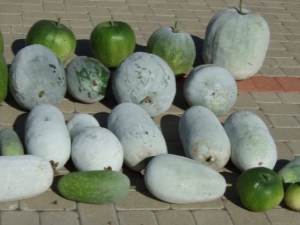Winter sweet pumpkin: features, varieties and cultivation

Pumpkin is quite familiar to domestic gardeners and gardeners.But this attractive plant is more diverse than it might seem at first glance. Of great importance are those varieties that are grown faster than others and allow you to get a tasty harvest.
Grade "Beninkaz": how to grow it and what you can expect
This winter sweet pumpkin is becoming more and more popular from year to year, although it has only been used recently. A unique feature of the plant is the ability to preserve the fruits for a year and even more at room temperature. The mechanism of biological protection - a special coating on the surface of the pumpkin. The wax layer reliably prevents not only damage, but also desiccation. The primary source of the variety is the rainforests of Southeast Asia.
"Beninkaz" is actively cultivated in Asian countries, where it is considered not just a variety of products, but also a valuable natural medicine. Pumpkin wax has a well-developed rhizome. Its stems are thin (no thicker than a pencil), its length is up to 4 m. The foliage is relatively small, its shape, like the appearance of flowers, resemble a cucumber. Judging by the reviews, "Beninkaz" has excellent decorative properties.
Almost always, the plant produces suitable for gathering fruits in October or November. For culinary purposes, both young growth and ripe pumpkin are used. In the tropics, wax gourds can grow up to 10 kg, but in Russia even the most diligent farmers can count on a maximum of 5 kg. As it grows, the flesh becomes sweeter, it can be used to produce:
- hot appetizers;
- candied fruit;
- soups.
Geographical origin left a strong imprint on the properties of the culture: “Beninkaz” is critically dependent on heat. It is recommended to use seedlings, since the earliest shoots do not survive the frost badly. Important: a transplant also causes severe stress on the plant. If it is not possible to cultivate a pumpkin quickly and from the first time, it is necessary to conduct experiments with shelter with a film next year. It is advisable to choose a place sunlit and not blown by the winds.
The soil is previously excavated, supplied with humus (5 or 6 kg per 1 sq. M. Surface). The addition of potash and phosphorus mixtures is made in the amount of 0.02-0.04 kg per 1 sq. Km. m. Landing is permissible only after a thorough warming up of the earth, a minimum of 1.5 square meters is required per bush. m free space. Previous and parallel crops do not play a special role: wax gourd is very sociable.
It doesn’t need any special care details - it is processed in the same way as other varieties.
Alternative culture
The large-fruited “Gribovskaya” pumpkin can also be of great benefit. Between sprout shoots and the appearance of technically ripe fruits normally passes from 128 to 140 days. Pumpkin forms elongated scourge, fruits have a mass of from 3 to 7 kg, characterized by thick juicy flesh. The concentration of solids can reach 20%, and the share of sugars accounts for up to 10%. The advantages of "Gribovskoy" are excellent ability to transport and good safety.
Pumpkin of this variety has universal application, within the central belt of the Russian Federation is cultivated mainly through seedlings. By the time of completion of the return frost, seedlings should be ready 2 or 3 weeks old. The recommended landing pattern is 0.7 x 1 m. All care is limited to almost systematic watering and application of supplements.
Recommendations on agricultural technology and additional information
Any winter gourd is valuable not only easy storage, but also rich in nutrients. The plant contains:
- vitamin A;
- vitamin C;
- potassium;
- manganese.
To get such a pleasant and important for the health of the fruit, you need to plant a pumpkin in places where its growing season will take at least 3.5 months. Almost all of this time will have to ripen, before it ends to pick fruits should not be. According to the botanical and agronomical description of the main varieties, seedlings are planted on the seedlings 21–28 days before the approximate completion of the cold weather.For places where the growing season is longer than the minimum norm, you can plant seeds directly into the free land 14 days after the early frost. When preparing the soil, the seed is covered with a warm, slightly damp cloth.
Seedlings grow in pots with a diameter of 8 cm. Conventional trays are almost always too small. It is necessary to cultivate seedlings on the most lighted window, and with a shortened daylight the lack of insolation is compensated by a special lamp.
Covering the pot with polyethylene in the initial days helps to increase germination. Usually the first shoots appear already on the 5–12th day.
To circumvent the limitation on the area, it is necessary to build a grid or use an existing fence for vertical pumpkin growing. Planted plants with a gap of 60 cm, sent to the side of the support. If possible, fertilize the land in winter using compost. In an open garden, seedlings are transferred after the earth warms up to 20 degrees. To loosen it should be 0.3 m, recommended landing in the upper points of embankments with a height of 1 m each. This technique allows you to eliminate rotting roots.
Important: for vertical growing mounds can not be used. But regardless of it, you can fight weeds, laying mulch around a vegetable in the first weeks of its growth. As soon as wide foliage is formed, we will have to weed the land by hand. Watering the soil is required as the soil dries. It is unacceptable to pour water on the leaves, otherwise a scab or powdery mildew will appear.
Review of the winter sweet pumpkin, see below.




























